Abstract
DNA ligase activity was studied in several untransformed or virus-transformed human cell lines from normal donors and from Bloom's syndrome (BS) patients. This proneness genetic disease is characterized by several cytological abnormalities and cancer proneness and, recently, some transformed cell lines from these patients were described to present a reduced activity of DNA ligase I. Results presented in this work indicate that: (i) the total DNA ligase activity in crude extract from untransformed or transformed cell lines from several BS patients was significantly higher than in control cells; (ii) the partial purification of the enzyme after gel filtration on fast protein liquid chromatography of crude extracts from lymphoblastoid BS cells showed that the enzyme activity was eluted in a major 180 kDa form in which activity was higher than in control cells; (iii) the activity gel analysis of these enzyme fractions revealed that DNA ligase of human cells was correlated to a major 130 kDa polypeptide and, in BS cells, the extent of the activity of this band was equal or higher than that in control untransformed or transformed cells.
Full text
PDF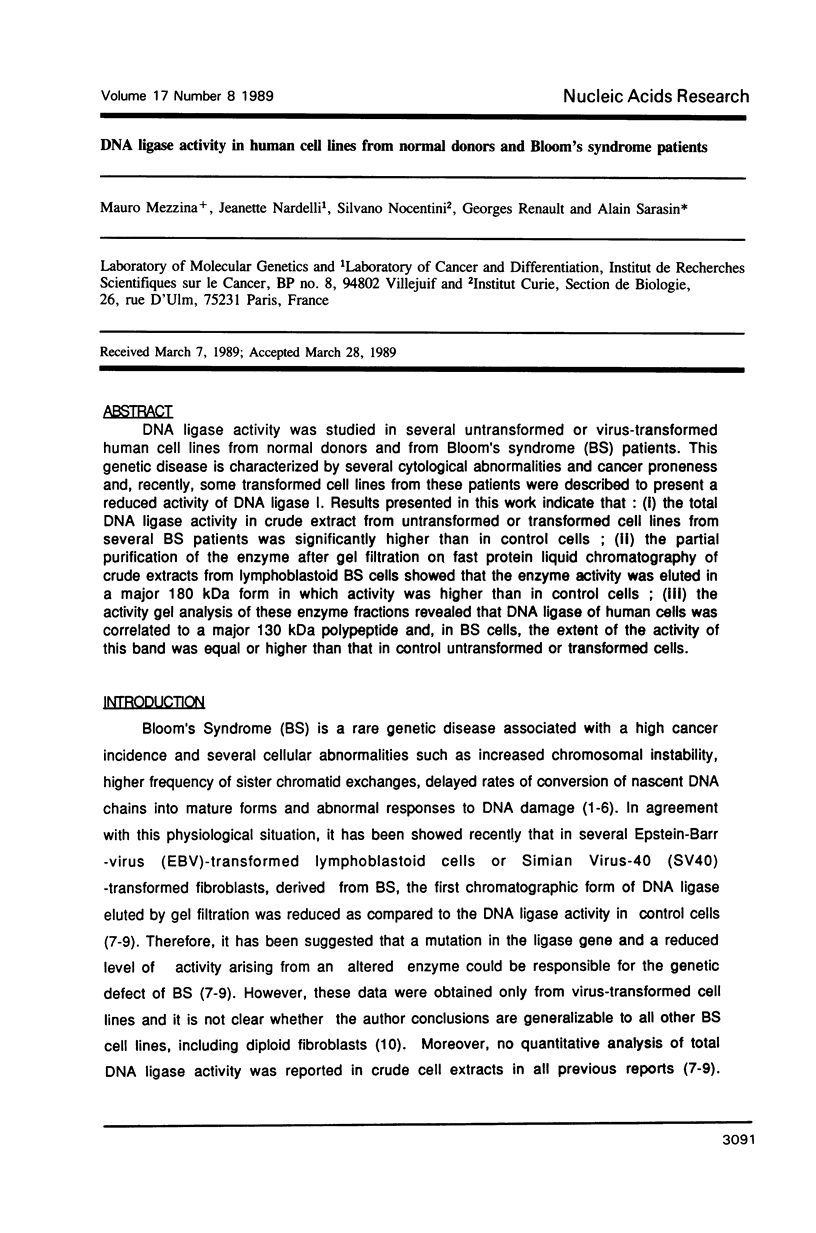
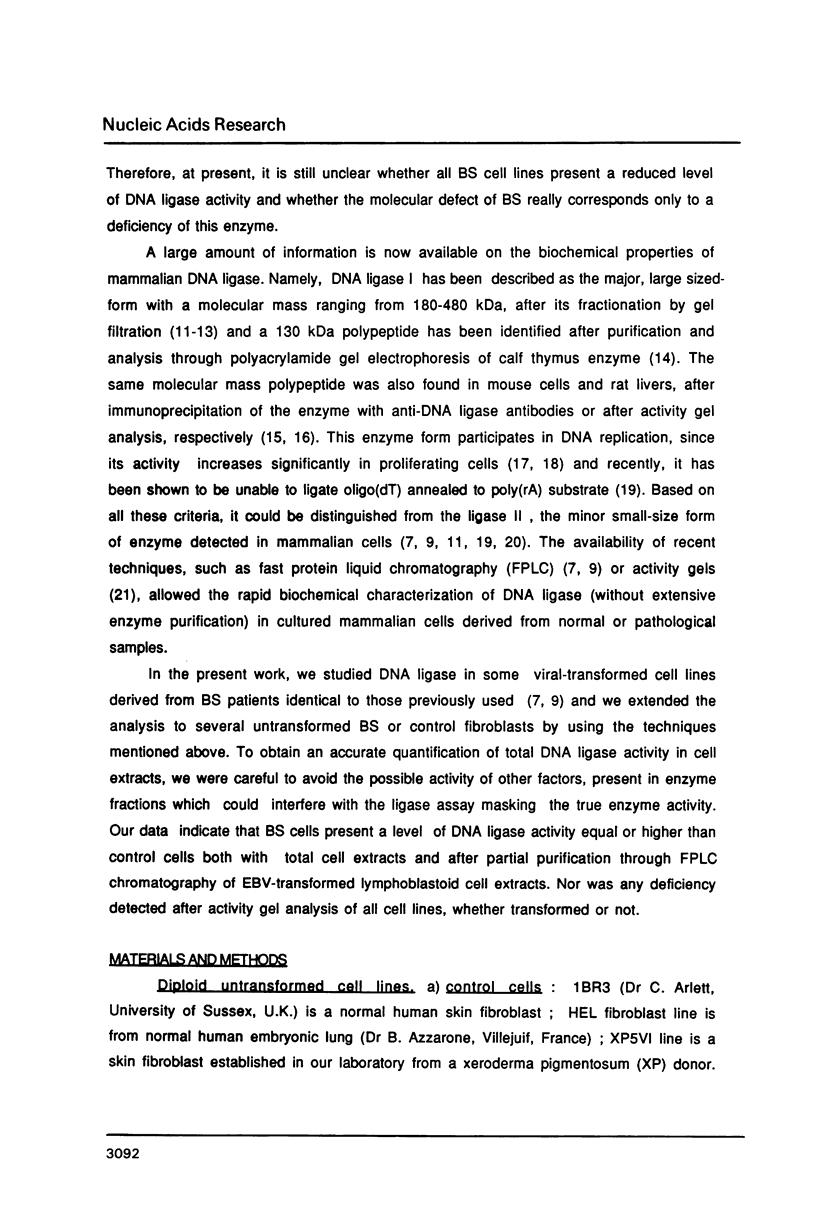
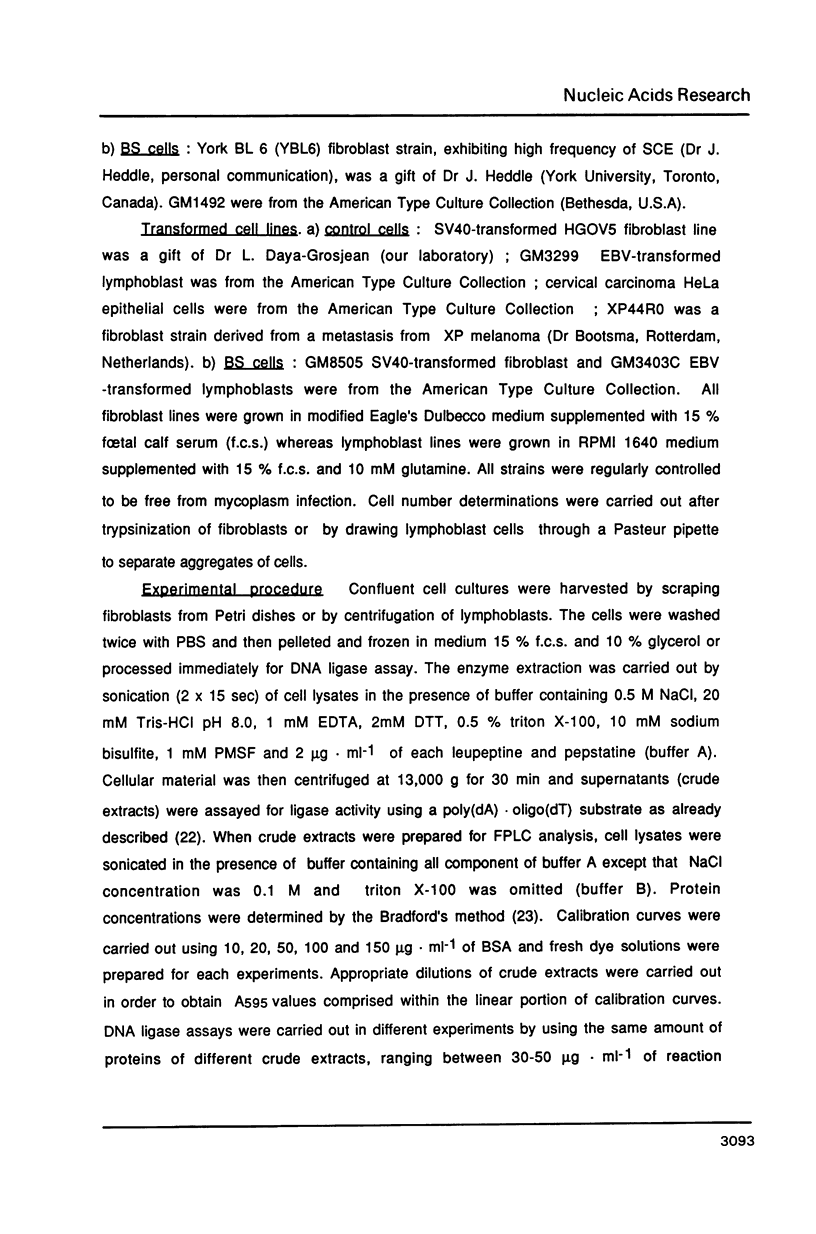
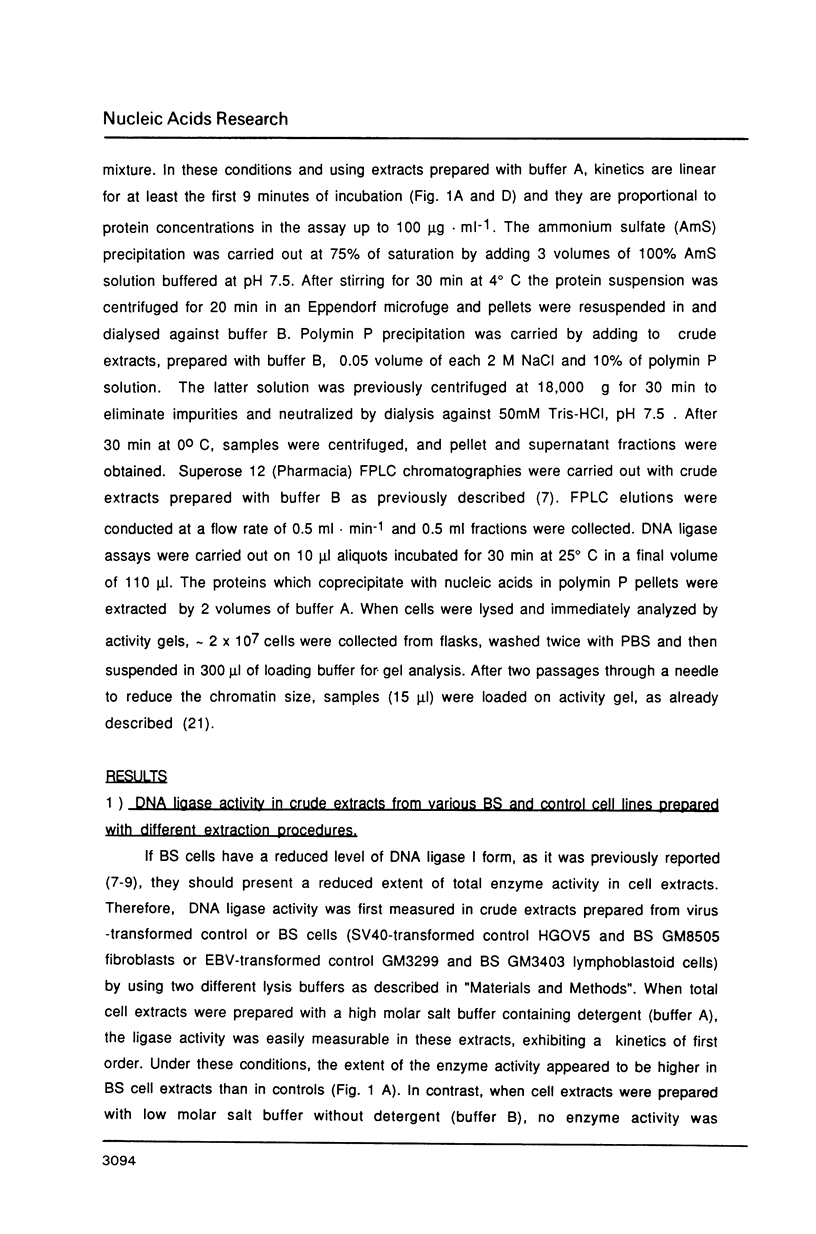
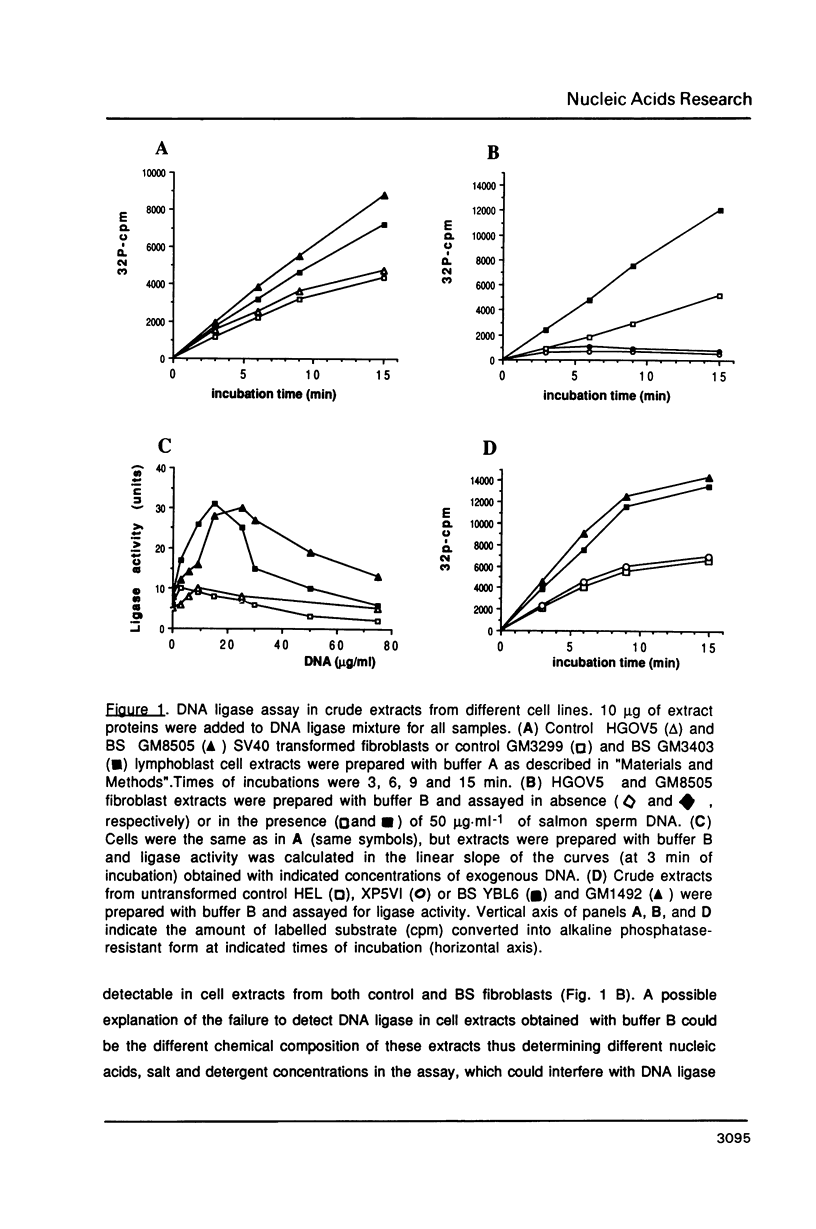
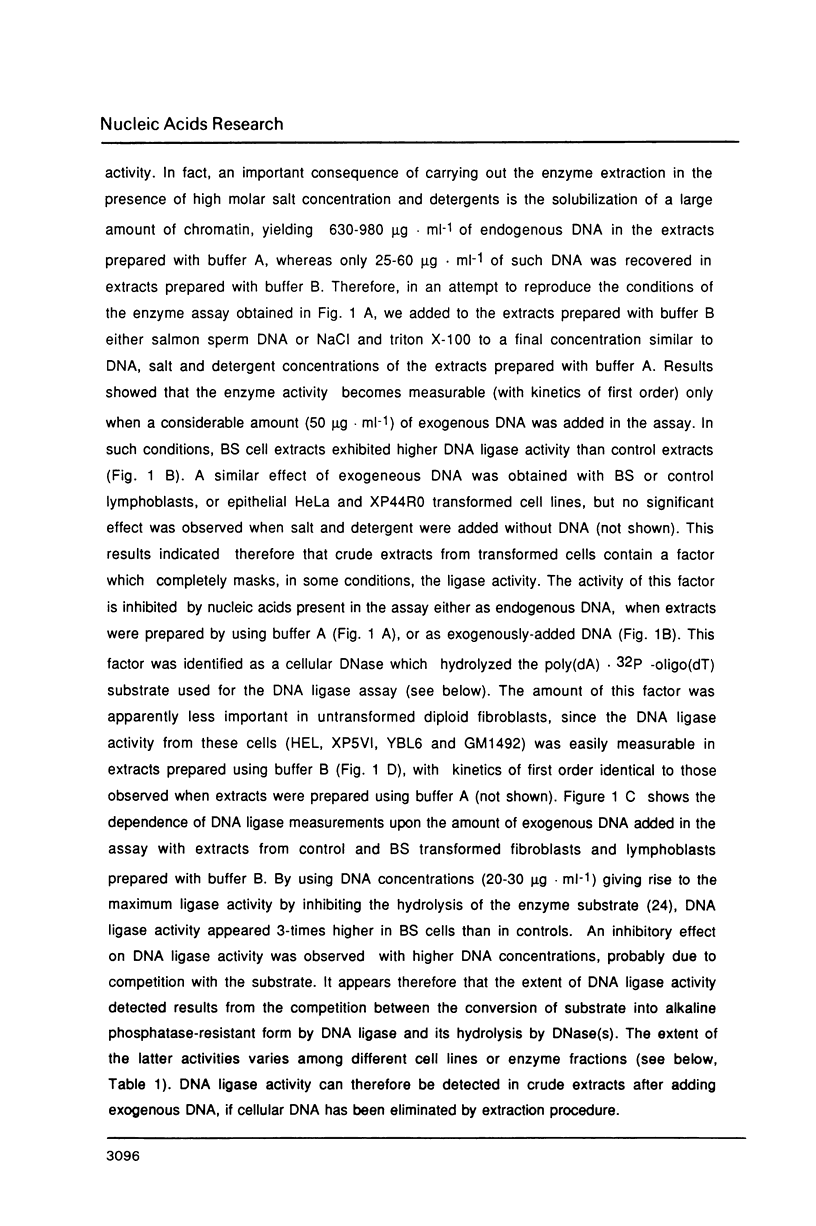
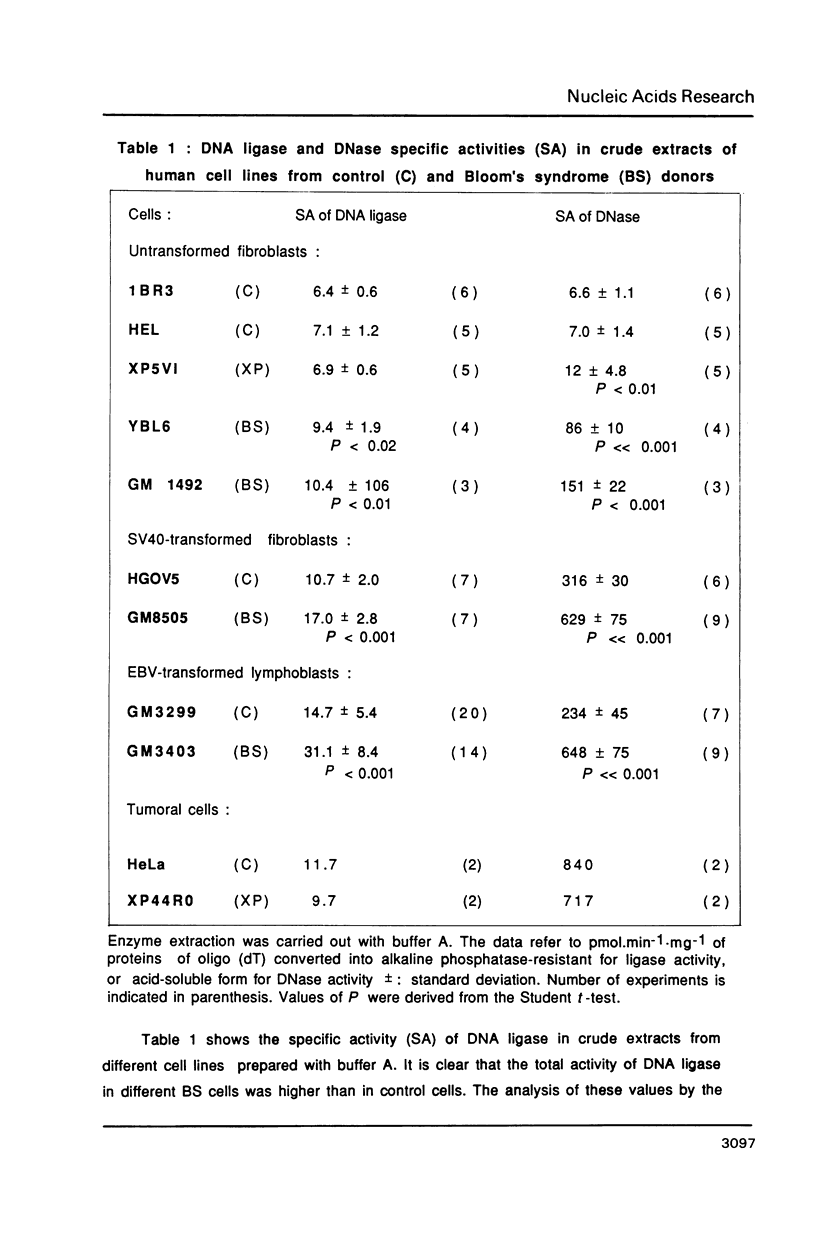
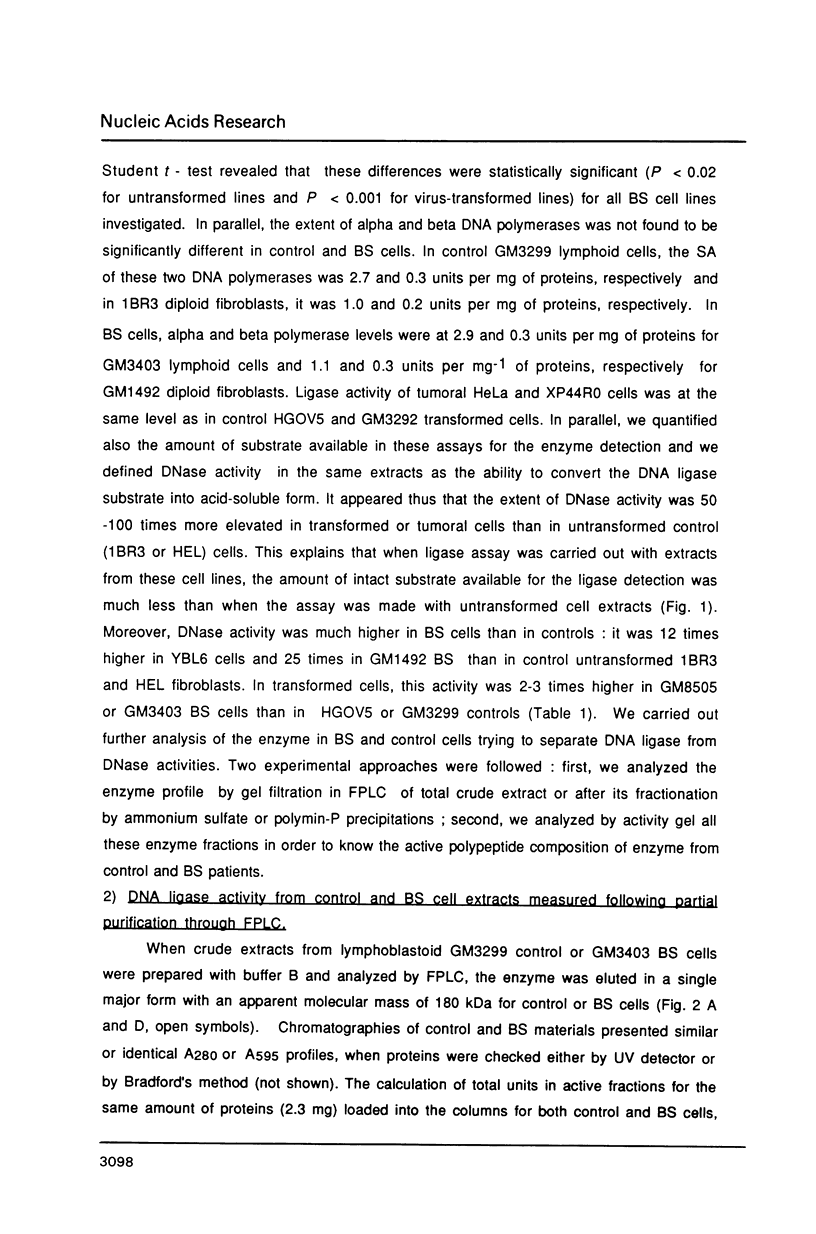
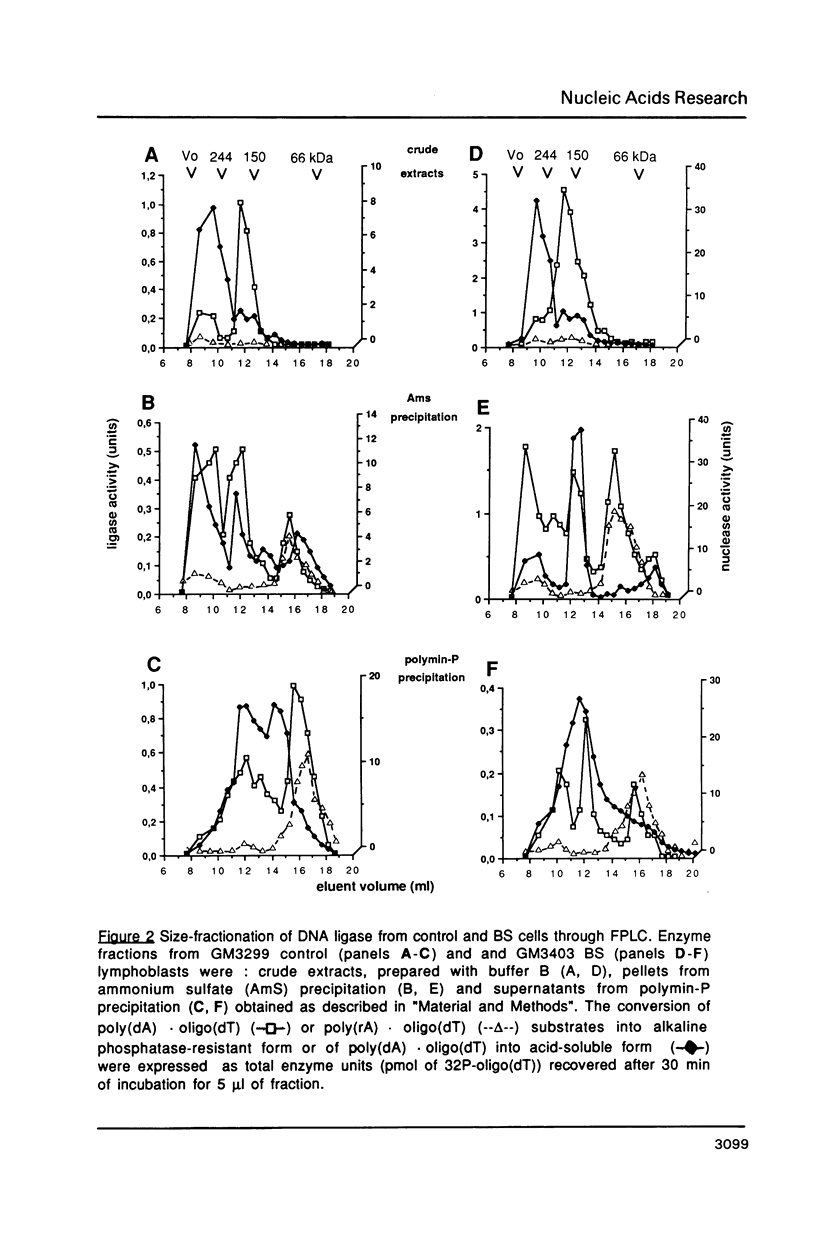
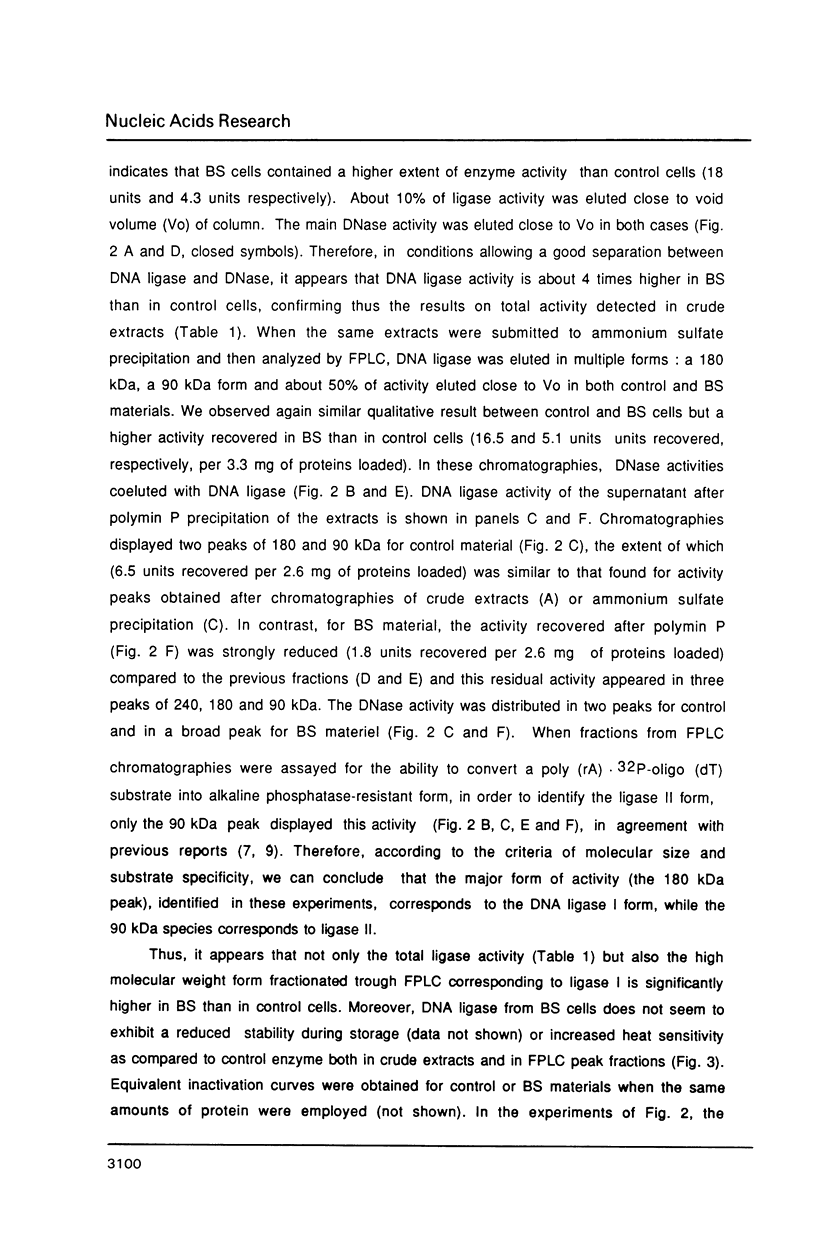
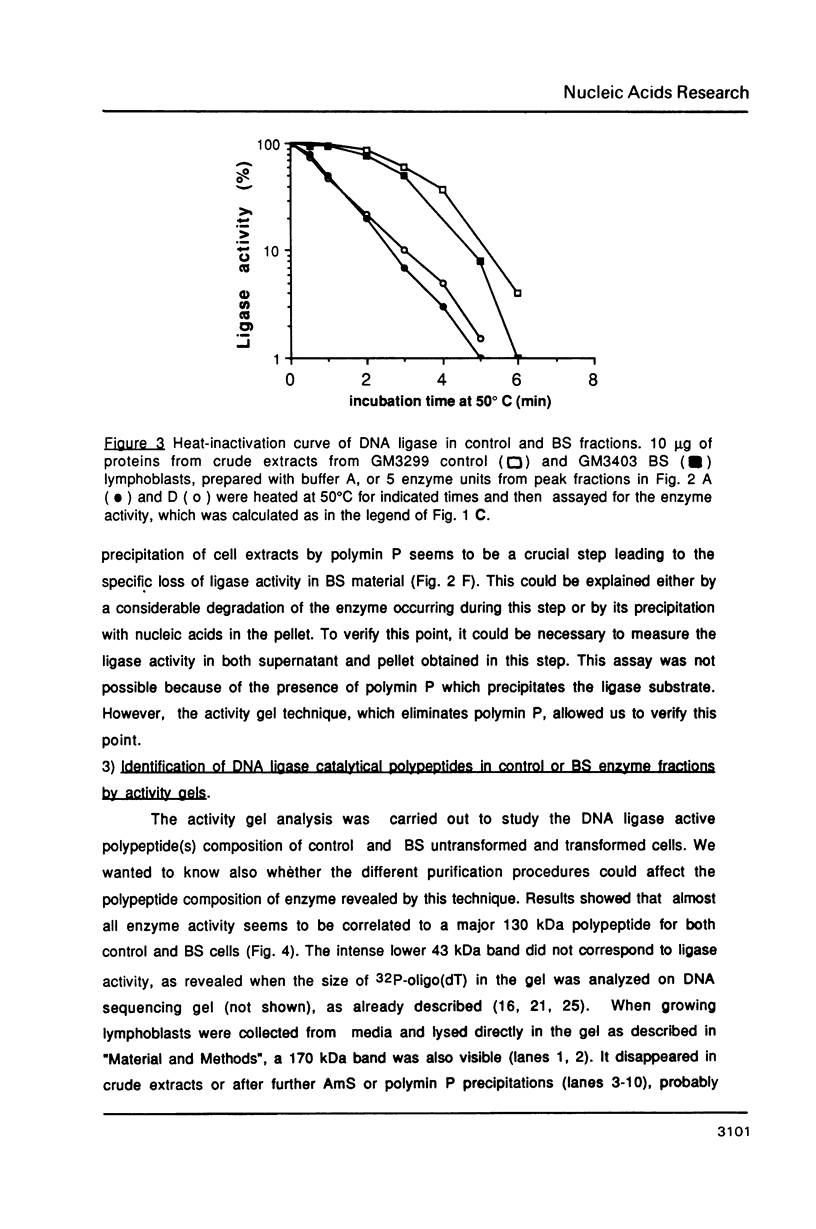
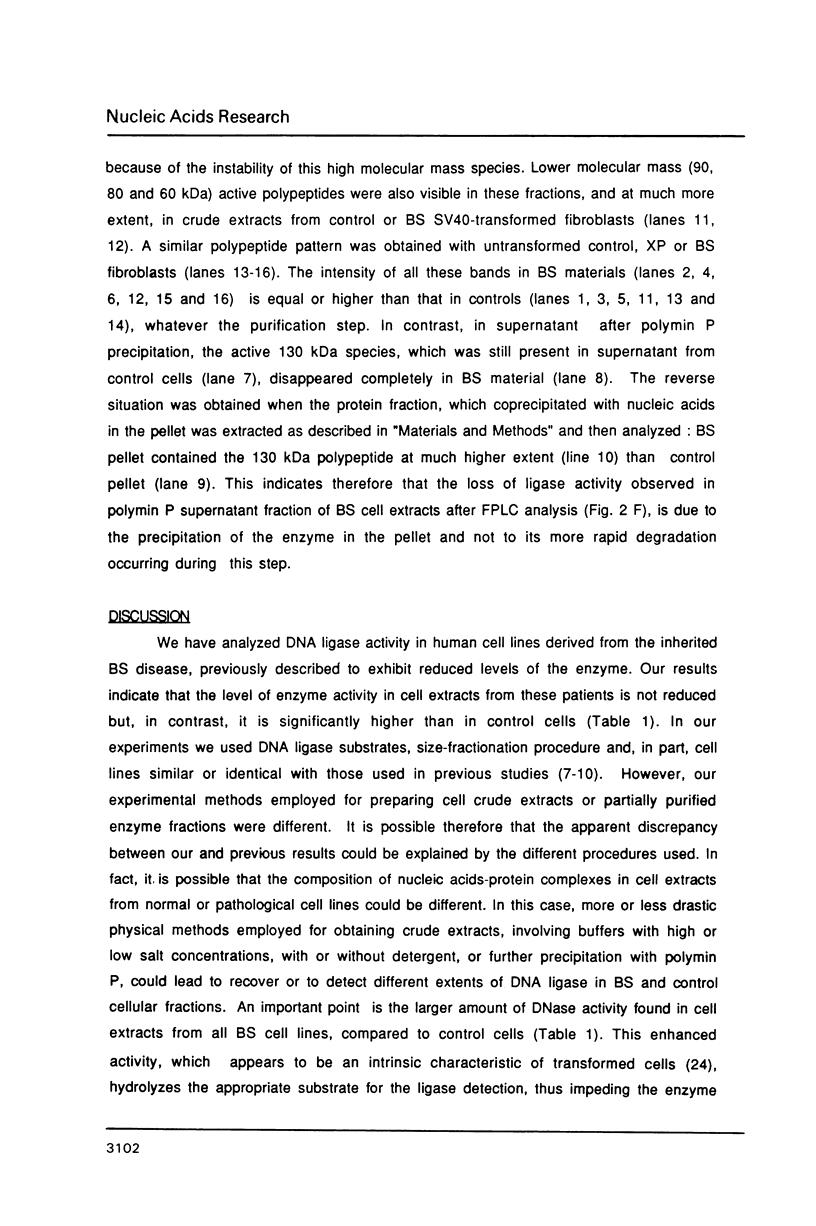
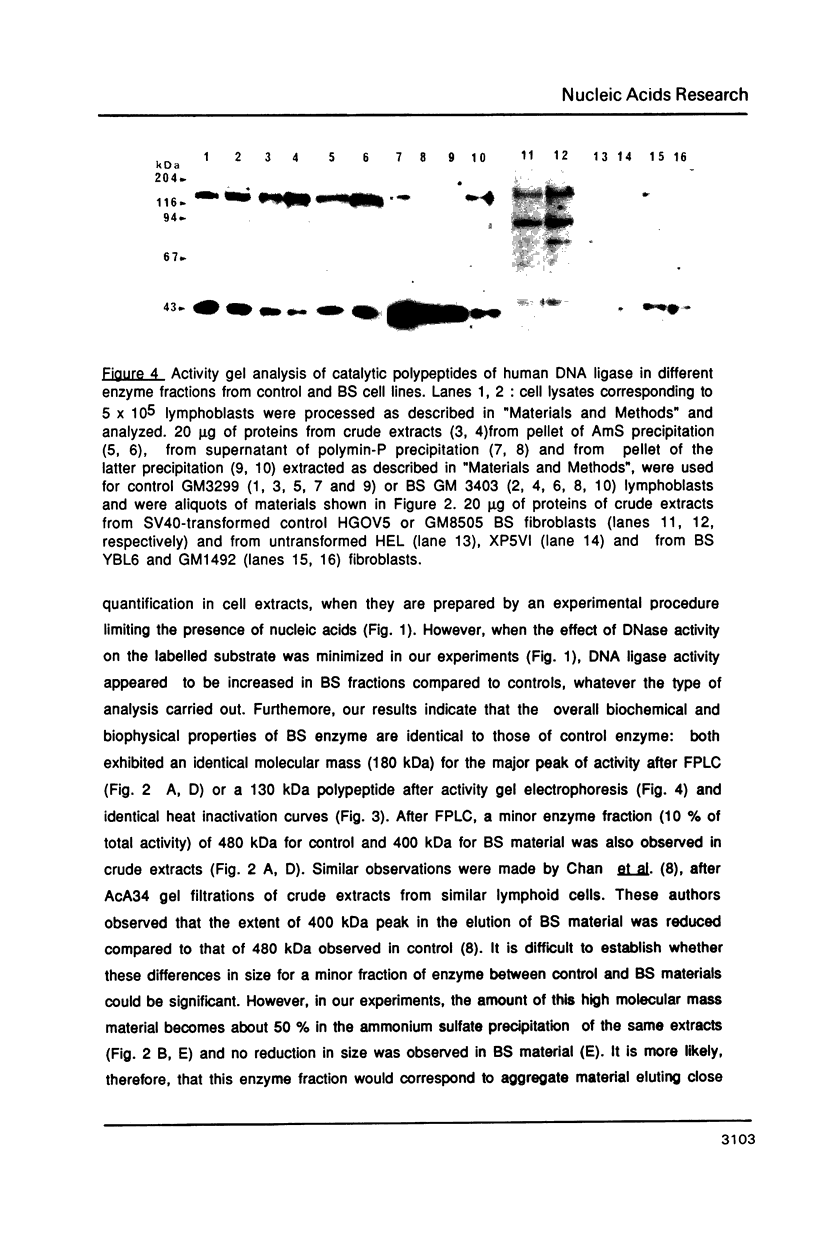
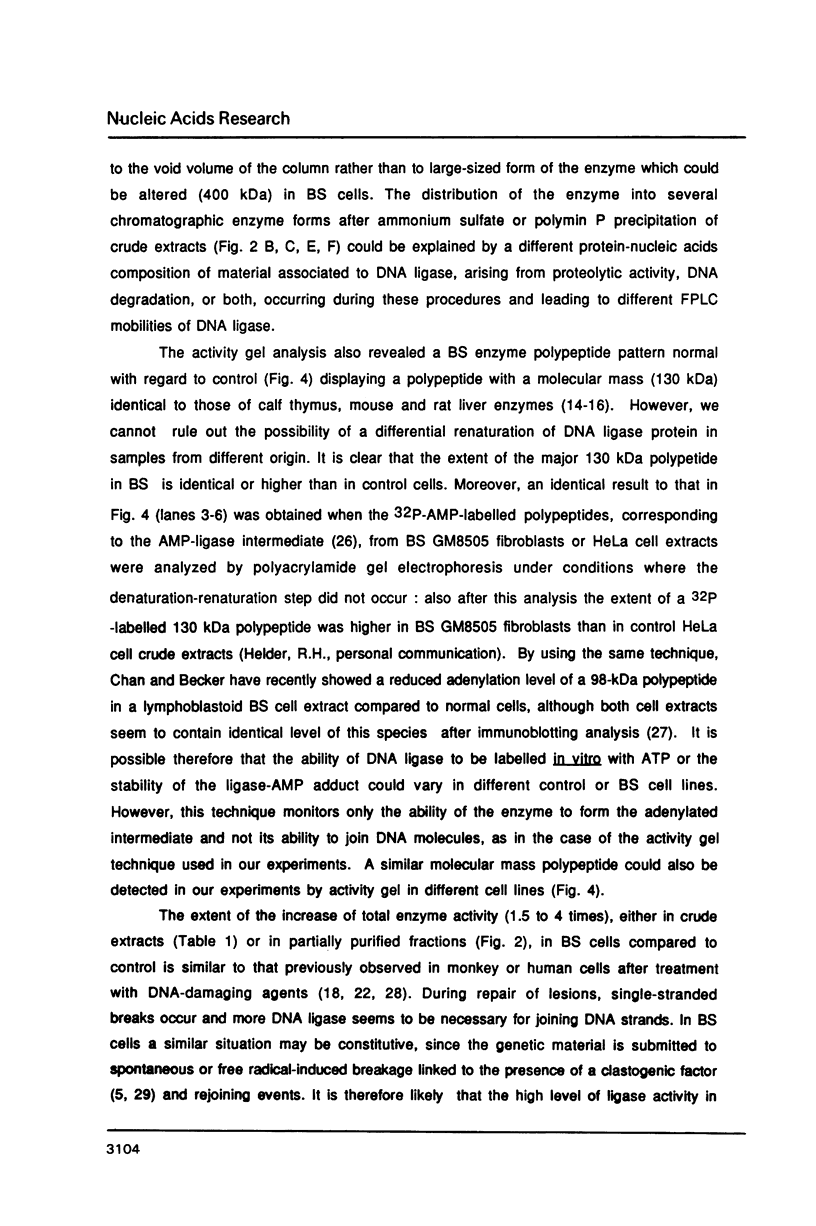
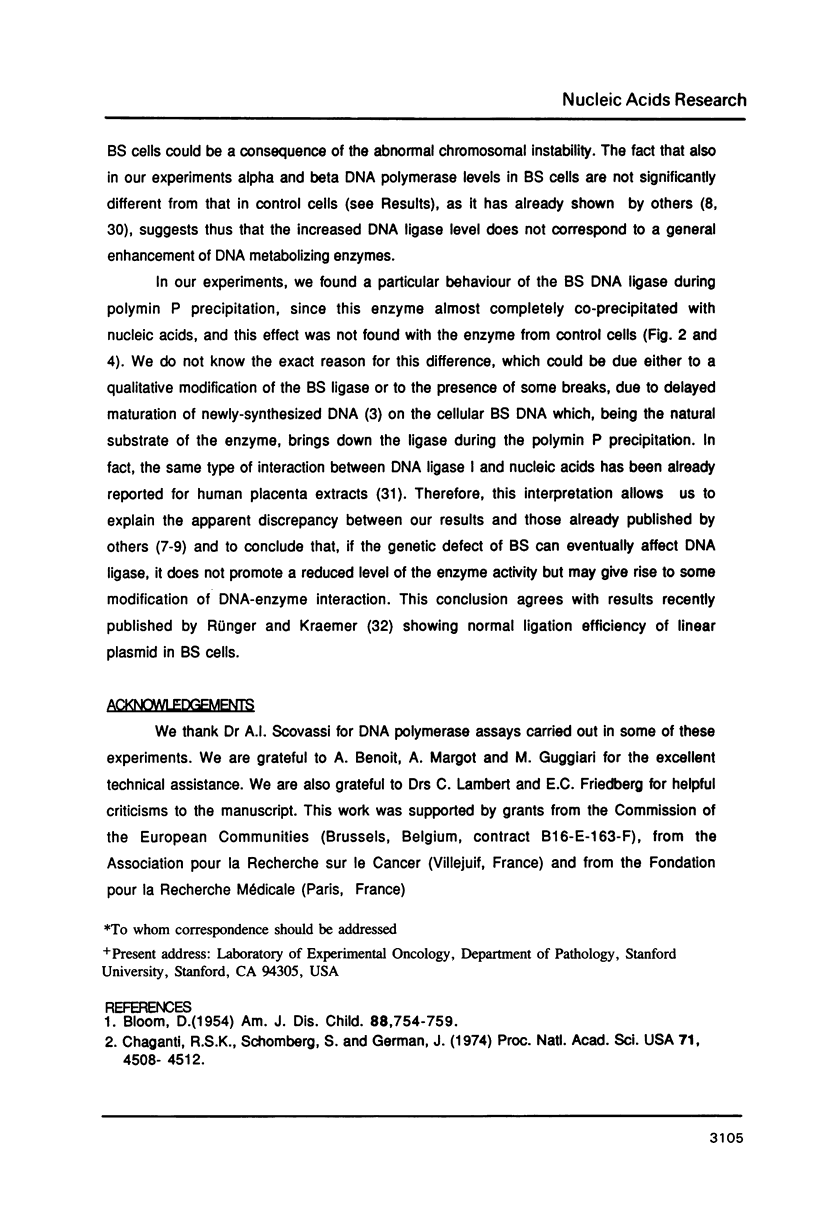
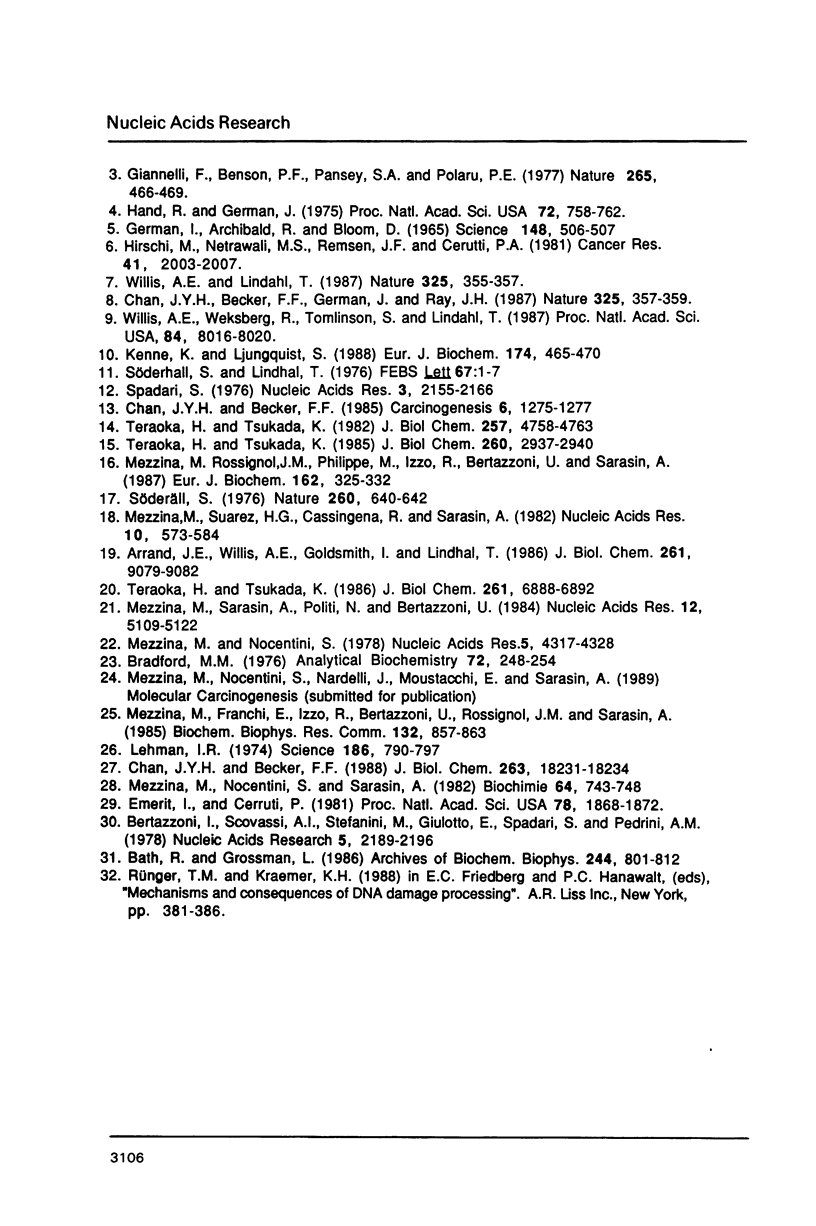
Images in this article
Selected References
These references are in PubMed. This may not be the complete list of references from this article.
- Arrand J. E., Willis A. E., Goldsmith I., Lindahl T. Different substrate specificities of the two DNA ligases of mammalian cells. J Biol Chem. 1986 Jul 15;261(20):9079–9082. [PubMed] [Google Scholar]
- BLOOM D. Congenital telangiectatic erythema resembling lupus erythematosus in dwarfs; probably a syndrome entity. AMA Am J Dis Child. 1954 Dec;88(6):754–758. [PubMed] [Google Scholar]
- Bertazzoni U., Scovassi A. I., Stefanini M., Giulotto E., Spadari S., Pedrini A. M. DNA polymerases alpha beta and gamma in inherited diseases affecting DNA repair. Nucleic Acids Res. 1978 Jun;5(6):2189–2196. doi: 10.1093/nar/5.6.2189. [DOI] [PMC free article] [PubMed] [Google Scholar]
- Bhat R., Grossman L. Purification and properties of two DNA ligases from human placenta. Arch Biochem Biophys. 1986 Feb 1;244(2):801–812. doi: 10.1016/0003-9861(86)90649-1. [DOI] [PubMed] [Google Scholar]
- Bradford M. M. A rapid and sensitive method for the quantitation of microgram quantities of protein utilizing the principle of protein-dye binding. Anal Biochem. 1976 May 7;72:248–254. doi: 10.1016/0003-2697(76)90527-3. [DOI] [PubMed] [Google Scholar]
- Chaganti R. S., Schonberg S., German J. A manyfold increase in sister chromatid exchanges in Bloom's syndrome lymphocytes. Proc Natl Acad Sci U S A. 1974 Nov;71(11):4508–4512. doi: 10.1073/pnas.71.11.4508. [DOI] [PMC free article] [PubMed] [Google Scholar]
- Chan J. Y., Becker F. F. DNA ligase activities during hepatocarcinogenesis induced by N-2-acetylaminofluorene. Carcinogenesis. 1985 Sep;6(9):1275–1277. doi: 10.1093/carcin/6.9.1275. [DOI] [PubMed] [Google Scholar]
- Chan J. Y., Becker F. F. Defective DNA ligase I in Bloom's syndrome cells. Simultaneous analysis using immunoblotting and the ligase-[32P]AMP adduct assay. J Biol Chem. 1988 Dec 5;263(34):18231–18235. [PubMed] [Google Scholar]
- Chan J. Y., Becker F. F., German J., Ray J. H. Altered DNA ligase I activity in Bloom's syndrome cells. Nature. 1987 Jan 22;325(6102):357–359. doi: 10.1038/325357a0. [DOI] [PubMed] [Google Scholar]
- Emerit I., Cerutti P. Clastogenic activity from Bloom syndrome fibroblast cultures. Proc Natl Acad Sci U S A. 1981 Mar;78(3):1868–1872. doi: 10.1073/pnas.78.3.1868. [DOI] [PMC free article] [PubMed] [Google Scholar]
- GERMAN J., ARCHIBALD R., BLOOM D. CHROMOSOMAL BREAKAGE IN A RARE AND PROBABLY GENETICALLY DETERMINED SYNDROME OF MAN. Science. 1965 Apr 23;148(3669):506–507. doi: 10.1126/science.148.3669.506. [DOI] [PubMed] [Google Scholar]
- Gianneli F., Benson P. F., Pawsey S. A., Polani P. E. Ultraviolet light sensitivity and delayed DNA-chain maturation in Bloom's syndrome fibroblasts. Nature. 1977 Feb 3;265(5593):466–469. doi: 10.1038/265466a0. [DOI] [PubMed] [Google Scholar]
- Hand R., German J. A retarded rate of DNA chain growth in Bloom's syndrome. Proc Natl Acad Sci U S A. 1975 Feb;72(2):758–762. doi: 10.1073/pnas.72.2.758. [DOI] [PMC free article] [PubMed] [Google Scholar]
- Hirschi M., Netrawali M. S., Remsen J. F., Cerutti P. A. Formation of DNA single-strand breaks by near-ultraviolet and gamma-rays in normal and Bloom's syndrome skin fibroblasts. Cancer Res. 1981 May;41(5):2003–2007. [PubMed] [Google Scholar]
- Kenne K., Ljungquist S. Expression of a DNA-ligase-stimulatory factor in Bloom's syndrome cell line GM1492. Eur J Biochem. 1988 Jun 15;174(3):465–470. doi: 10.1111/j.1432-1033.1988.tb14121.x. [DOI] [PubMed] [Google Scholar]
- Lehman I. R. DNA ligase: structure, mechanism, and function. Science. 1974 Nov 29;186(4166):790–797. doi: 10.1126/science.186.4166.790. [DOI] [PubMed] [Google Scholar]
- Mezzina M., Franchi E., Izzo R., Bertazzoni U., Rossignol J. M., Sarasin A. Variation in DNA ligase structure during repair and replication processes in monkey kidney cells. Biochem Biophys Res Commun. 1985 Nov 15;132(3):857–863. doi: 10.1016/0006-291x(85)91886-8. [DOI] [PubMed] [Google Scholar]
- Mezzina M., Nocentini S. DNA ligase activity in UV-irradiated monkey kidney cells. Nucleic Acids Res. 1978 Nov;5(11):4317–4328. doi: 10.1093/nar/5.11.4317. [DOI] [PMC free article] [PubMed] [Google Scholar]
- Mezzina M., Nocentini S., Sarasin A. DNA ligase activity in carcinogen-treated human fibroblasts. Biochimie. 1982 Aug-Sep;64(8-9):743–748. doi: 10.1016/s0300-9084(82)80122-3. [DOI] [PubMed] [Google Scholar]
- Mezzina M., Rossignol J. M., Philippe M., Izzo R., Bertazzoni U., Sarasin A. Mammalian DNA ligase. Structure and function in rat-liver tissues. Eur J Biochem. 1987 Jan 15;162(2):325–332. doi: 10.1111/j.1432-1033.1987.tb10604.x. [DOI] [PubMed] [Google Scholar]
- Mezzina M., Sarasin A., Politi N., Bertazzoni U. Heterogeneity of mammalian DNA ligase detected on activity and DNA sequencing gels. Nucleic Acids Res. 1984 Jun 25;12(12):5109–5122. doi: 10.1093/nar/12.12.5109. [DOI] [PMC free article] [PubMed] [Google Scholar]
- Spadari S. Properties of DNA ligase from uninfected and virus-infected HeLa cells. Nucleic Acids Res. 1976 Aug;3(8):2155–2167. doi: 10.1093/nar/3.8.2155. [DOI] [PMC free article] [PubMed] [Google Scholar]
- Teraoka H., Sumikawa T., Tsukada K. Purification of DNA ligase II from calf thymus and preparation of rabbit antibody against calf thymus DNA ligase II. J Biol Chem. 1986 May 25;261(15):6888–6892. [PubMed] [Google Scholar]
- Teraoka H., Tsukada K. Biosynthesis of mammalian DNA ligase. J Biol Chem. 1985 Mar 10;260(5):2937–2940. [PubMed] [Google Scholar]
- Teraoka H., Tsukada K. Eukaryotic DNA ligase. Purification and properties of the enzyme from bovine thymus, and immunochemical studies of the enzyme from animal tissues. J Biol Chem. 1982 May 10;257(9):4758–4763. [PubMed] [Google Scholar]
- Willis A. E., Lindahl T. DNA ligase I deficiency in Bloom's syndrome. Nature. 1987 Jan 22;325(6102):355–357. doi: 10.1038/325355a0. [DOI] [PubMed] [Google Scholar]
- Willis A. E., Weksberg R., Tomlinson S., Lindahl T. Structural alterations of DNA ligase I in Bloom syndrome. Proc Natl Acad Sci U S A. 1987 Nov;84(22):8016–8020. doi: 10.1073/pnas.84.22.8016. [DOI] [PMC free article] [PubMed] [Google Scholar]



